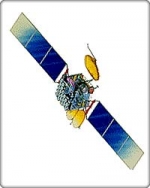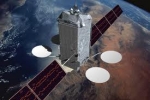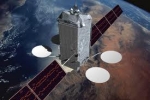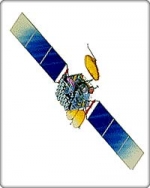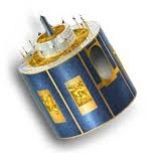Displaying items by tag: geostationary
Boeing 601 satellite
The Boeing 601 satellite is a body-stabilized geostationary satellite.
The Boeing 601 was introduced in 1987 to meet anticipated requirements for high-power, multiple-payload satellites for such applications as direct television broadcasting to small receiving antennas, very small aperture terminals for private business networks, and mobile communications. The basic configuration features as many as 48 transponders and offers up to 4,800 watts.
A more powerful version, the Boeing 601HP, made its debut in 1995. The HP versions can carry payloads twice as powerful as the classic Boeing 601 models, through such innovations as gallium arsenide solar cells, advanced battery technology, and an optional xenon ion propulsion system. The 601HP features as many as 60 transponders and provides up to 10,000 watts.
All Boeing 601 spacecraft use the same basic bus design, enabling Boeing to realize efficiencies gained by production volume, tooling investments and quantity buys.
Boeing 702 satellite
The Boeing 702 satellite is a family of geostationnary satellites designed and manufactured by the company Boeing.
Its design requirements include lower cost and high reliability. It offers a broad spectrum of modularity. A primary example is payload/bus integration. After the payload is tailored to customer specifications, the payload module mounts to the common bus module at only four locations and with only six electrical connectors. This design simplicity confers advantages. First, nonrecurring program costs are reduced, because the bus does not need to be changed for every payload, and payloads can be freely tailored without affecting the bus. Second, the design permits faster parallel bus and payload processing. This leads to the third advantage: a short production schedule.
Further efficiency derives from the 702's advanced xenon ion propulsion system (XIPS), which was pioneered by Boeing. XIPS is 10 times more efficient than conventional liquid fuel systems. Four 25-cm thrusters provide economical stationkeeping, needing only 5 kg of fuel per year - a fraction of what bipropellant or arcjet systems consume. Using XIPS for final orbit insertion conserves more mass as compared to using an on-board liquid apogee engine. Customers can apply the weight savings to increase the revenue-generating payload, to prolong service life, or to change to a less expensive launch vehicle (when cost is based on satellite mass).
Boeing 702 satellite
The Boeing 702 satellite is a family of geostationnary satellites designed and manufactured by the company Boeing.
Its design requirements include lower cost and high reliability. It offers a broad spectrum of modularity. A primary example is payload/bus integration. After the payload is tailored to customer specifications, the payload module mounts to the common bus module at only four locations and with only six electrical connectors. This design simplicity confers advantages. First, nonrecurring program costs are reduced, because the bus does not need to be changed for every payload, and payloads can be freely tailored without affecting the bus. Second, the design permits faster parallel bus and payload processing. This leads to the third advantage: a short production schedule.
Further efficiency derives from the 702's advanced xenon ion propulsion system (XIPS), which was pioneered by Boeing. XIPS is 10 times more efficient than conventional liquid fuel systems. Four 25-cm thrusters provide economical stationkeeping, needing only 5 kg of fuel per year - a fraction of what bipropellant or arcjet systems consume. Using XIPS for final orbit insertion conserves more mass as compared to using an on-board liquid apogee engine. Customers can apply the weight savings to increase the revenue-generating payload, to prolong service life, or to change to a less expensive launch vehicle (when cost is based on satellite mass).
Boeing 601 satellite
The Boeing 601 satellite is a body-stabilized geostationary satellite.
The Boeing 601 was introduced in 1987 to meet anticipated requirements for high-power, multiple-payload satellites for such applications as direct television broadcasting to small receiving antennas, very small aperture terminals for private business networks, and mobile communications. The basic configuration features as many as 48 transponders and offers up to 4,800 watts.
A more powerful version, the Boeing 601HP, made its debut in 1995. The HP versions can carry payloads twice as powerful as the classic Boeing 601 models, through such innovations as gallium arsenide solar cells, advanced battery technology, and an optional xenon ion propulsion system. The 601HP features as many as 60 transponders and provides up to 10,000 watts.
All Boeing 601 spacecraft use the same basic bus design, enabling Boeing to realize efficiencies gained by production volume, tooling investments and quantity buys.
MSG - Meteosat Second Generation
MSG, Meteosat Second Generation, is a serie of geostationary meteorological satellites operated by EUMETSAT.
It consists of a series of four geostationary meteorological satellites, along with ground-based infrastructure, that will operate consecutively until 2020. The MSG satellites carry a pair of instruments — the Spinning Enhanced Visible and InfraRed Imager (SEVIRI), which has the capacity to observe the Earth in 12 spectral channels and provide image data which is core to operational forecasting needs, and the Geostationary Earth Radiation Budget (GERB) instrument supporting climate studies.
It was designed in response to user requirements to serve the needs of Nowcasting applications and numerical weather prediction. In addition the GERB instrument provides important data for climate monitoring and research.
The MSG satellites are spin-stabilised like the previous generation, but with many design improvements. The more frequent and comprehensive data collected by MSG also aids the weather forecaster in the swift recognition and prediction of dangerous weather phenomena such as thunderstorms, fog and explosive development of small but intense depressions which can lead to devastating wind storms.
The MSG satellites are 3.2 m in diameter and 2.4 m high and spins anti-clockwise at 100 RPM at an altitude of 36,000 km.
On January 29, 2004 the first Meteosat Second Generation satellite MSG-1, renamed to Meteosat-8, commenced routine operations.
Astra (satellite)
Astra is the brand name for a number of geostationary communication satellites, both individually and as a group, which are owned and operated by SES S.A., a global satellite operator based in Betzdorf, in eastern Luxembourg. The name is also used to describe the pan-European broadcasting system provided by these satellites, the channels carried on them, and even the reception equipment.
Inmarsat
Inmarsat plc is a British satellite telecommunications company, offering global, mobile services, using a fleet of communications satellites. It provides telephony and data services to users worldwide, via portable or mobile terminals which communicate to ground stations through eleven geostationary telecommunications satellites. Inmarsat's network provides communications services to a range of governments, aid agencies, media outlets and businesses with a need to communicate in remote regions or where there is no reliable terrestrial network.
Aside from its commercial services, Inmarsat provides global maritime distress and safety services (GMDSS) to ships and aircraft at no charge, as a public service.
The Inmarsat satellites are digital transponders that receive digital signals, reform the pulses, and then retransmit them to ground stations. Ground stations maintain usage and billing data and function as gateways to the public switched telephone network and the Internet.

